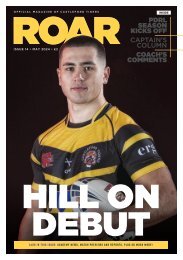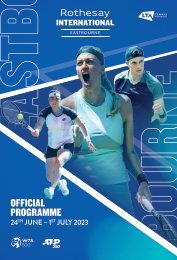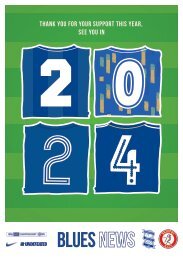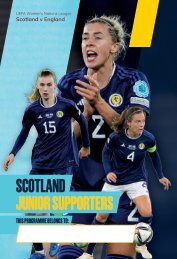Premiership Rugby Salary Cap Report 2020-21
An official report, published by Premiership Rugby in June 2022, that provides information about the operation and management of Premiership Rugby's Salary Cap in respect of the 2020-21 Salary Cap Year.
An official report, published by Premiership Rugby in June 2022, that provides information about the operation and management of Premiership Rugby's Salary Cap in respect of the 2020-21 Salary Cap Year.
Create successful ePaper yourself
Turn your PDF publications into a flip-book with our unique Google optimized e-Paper software.
SALARY CAP REPORT<br />
<strong>2020</strong>-<strong>21</strong><br />
SALARY CAP REPORT <strong>2020</strong>-<strong>21</strong> | 1
CONTENTS<br />
03 INTRODUCTION<br />
04 HISTORY OF THE PREMIERSHIP RUGBY<br />
SALARY CAP<br />
05 SALARY CAP BACKGROUND<br />
06 OPERATION & MANAGEMENT<br />
OF THE SALARY CAP<br />
09 PLAYERS USED AND SQUAD SIZES<br />
10 PLAYER SALARY INSIGHTS<br />
18 EXCLUDED PLAYERS<br />
19 GLOSSARY<br />
2 | SALARY CAP REPORT <strong>2020</strong>-<strong>21</strong>
INTRODUCTION<br />
The <strong>Salary</strong> <strong>Cap</strong> continues to be a crucial part of <strong>Premiership</strong> <strong>Rugby</strong>’s<br />
strategic framework and is supported unanimously by all 13 <strong>Premiership</strong><br />
<strong>Rugby</strong> Clubs.<br />
Established in 1999, the <strong>Salary</strong> <strong>Cap</strong> framework is under constant review but in<br />
<strong>2020</strong> it underwent some crucial changes inspired by a report written by former<br />
cabinet minister Lord Paul Myners and commissioned by <strong>Premiership</strong> <strong>Rugby</strong>.<br />
One of the main principles set out in the Myners <strong>Report</strong> emphasised the promotion<br />
of greater transparency, to broaden and deepen visibility and scrutiny about how<br />
the <strong>Salary</strong> <strong>Cap</strong> operates in practice. This report, which covers the season <strong>2020</strong>-<strong>21</strong><br />
is borne from his recommendations and will become an annual publication.<br />
It was very sad to hear of the passing of Lord Myners earlier this year. <strong>Premiership</strong><br />
<strong>Rugby</strong> is extremely grateful for the huge amount of time and commitment he put<br />
into the review. We believe that through his report and recommendations he has<br />
helped us continue to operate a world-leading system.<br />
This <strong>Report</strong> provides information about the operation and management of<br />
<strong>Premiership</strong> <strong>Rugby</strong>’s <strong>Salary</strong> <strong>Cap</strong> in respect of the <strong>2020</strong>-<strong>21</strong> <strong>Salary</strong> <strong>Cap</strong> Year.<br />
If you have any questions or would like further details please contact the media<br />
team at <strong>Premiership</strong> <strong>Rugby</strong> via communications@premiershiprugby.com<br />
Simon Massie-Taylor<br />
Chief Executive Officer, <strong>Premiership</strong> <strong>Rugby</strong><br />
SALARY CAP REPORT <strong>2020</strong>-<strong>21</strong> | 3
HISTORY OF THE PREMIERSHIP<br />
RUGBY SALARY CAP<br />
As a collective, <strong>Premiership</strong> <strong>Rugby</strong> and its Clubs led the way in England<br />
when they introduced a <strong>Salary</strong> <strong>Cap</strong> in 1999 with the aim of achieving the<br />
following objectives in a proportionate manner:<br />
• ensuring the financial viability of all Clubs and of the Gallagher <strong>Premiership</strong><br />
<strong>Rugby</strong> competition;<br />
• controlling inflationary pressures on Clubs’ costs;<br />
• providing a level playing field for Clubs;<br />
• ensuring a competitive Gallagher <strong>Premiership</strong> competition; and<br />
• enabling Clubs to compete in European competitions.<br />
The <strong>Salary</strong> <strong>Cap</strong> has been kept under continuous review each year but in 2019 the<br />
<strong>Salary</strong> <strong>Cap</strong> was subject to a challenge on competition law grounds to the validity<br />
of the Regulations. The Independent Panel, chaired by Lord Dyson, rejected the<br />
challenge and in setting out its conclusions, the Panel noted that the <strong>Salary</strong> <strong>Cap</strong><br />
operates in a pro-competitive manner by promoting the system’s objectives.<br />
The fact that the <strong>Salary</strong> <strong>Cap</strong> was kept under continuous review by <strong>Premiership</strong><br />
<strong>Rugby</strong> and the Clubs was a notable factor in the successful competition law<br />
defence.<br />
This decision and the Panel’s strong endorsement for the <strong>Salary</strong> <strong>Cap</strong>, presented the<br />
perfect springboard to undertake an extensive review of the <strong>Salary</strong> Regulations.<br />
As stated above Lord Myners led a comprehensive review of the <strong>Salary</strong> <strong>Cap</strong>,<br />
which was published in May <strong>2020</strong> and had the purpose of further strengthening<br />
the Regulations to ensure they provide a world-leading system with extensive<br />
investigatory powers and appropriately robust sanctions. Lord Myners’ review<br />
included a public consultation and meetings with every <strong>Premiership</strong> Club, the RPA<br />
and the RFU.<br />
His report made a number of recommendations which have been incorporated into<br />
the new system which started during the <strong>2020</strong>-<strong>21</strong> <strong>Salary</strong> <strong>Cap</strong> Year.<br />
4 | SALARY CAP REPORT <strong>2020</strong>-<strong>21</strong>
SALARY CAP BACKGROUND<br />
The <strong>Salary</strong> <strong>Cap</strong> is a <strong>Premiership</strong> <strong>Rugby</strong> rule that places a limit on the amount<br />
of money a Club can spend on Player salaries. The restriction is on the total<br />
squad spend, not on individual salaries. The level of the cap is determined by the<br />
<strong>Premiership</strong> <strong>Rugby</strong> Clubs and for the <strong>2020</strong>-<strong>21</strong> season was set at £6,400,000 for<br />
senior squads. A number of relief mechanisms are available to Clubs including<br />
credits, injury dispensations and other allowances that are excluded from the<br />
<strong>Salary</strong> <strong>Cap</strong>.<br />
EXCLUDED<br />
PLAYER<br />
1<br />
EDUCATION<br />
ALLOWANCE<br />
(unlimited)<br />
INJURED<br />
PLAYER<br />
CREDIT<br />
(£400,000)<br />
£6.4M<br />
SALARY<br />
CAP<br />
INTERNATIONAL<br />
PLAYER CREDITS<br />
(up to £80,000<br />
per Player)<br />
EXCLUDED<br />
PLAYER<br />
2<br />
HOME<br />
GROWN PLAYER<br />
CREDITS<br />
(£50,000 x 12)<br />
The Clubs are actively involved in the development of the <strong>Salary</strong> <strong>Cap</strong>. The level<br />
of the <strong>Salary</strong> <strong>Cap</strong> and the Regulations that support it are set by the PRL Investor<br />
Board (all 13 Clubs). To make any change at least 10 of the 13 Clubs need to<br />
support any proposal. In the last few seasons, these have been unanimous across<br />
the Clubs. There is also a <strong>Salary</strong> <strong>Cap</strong> Sub-Committee that includes representatives<br />
from five Clubs, as well as the <strong>Salary</strong> <strong>Cap</strong> Director and the <strong>Rugby</strong> Director, who<br />
review the Regulations and make recommendations to the Investor Board for<br />
consideration.<br />
SALARY CAP REPORT <strong>2020</strong>-<strong>21</strong> | 5
OPERATION & MANAGEMENT<br />
OF THE SALARY CAP<br />
The new system has expanded the scope of the Regulations to ensure all<br />
“Participants” have a shared responsibility to support in the compliance<br />
of the <strong>Salary</strong> <strong>Cap</strong>. These now cover, not only the Club itself, but also, its<br />
shareholders, directors, employees and Players, as well as Agents. All of<br />
these people must comply with the Regulations and actively support in a<br />
number of areas.<br />
“Each Participant agrees to act honestly, with integrity and in<br />
accordance with the spirit of the Regulations”<br />
There is also a strict obligation on all Participants to:<br />
• Fully co-operating with the <strong>Salary</strong> <strong>Cap</strong> Director<br />
• Provide true and accurate information to the <strong>Salary</strong> <strong>Cap</strong> Director<br />
• Not assist or take part in any attempt to breach or get around the<br />
Regulations<br />
• <strong>Report</strong> any breaches<br />
Failure to Co-operate is now a serious offence under the Regulations.<br />
In addition to the ongoing day-to-day management of the <strong>Salary</strong> <strong>Cap</strong> there are<br />
some key requirements that take place at specific times. These are:<br />
• Club Annual Declarations (30 June) – detailed forecast for the<br />
year signed off by the Chair, CEO, FD and Director of <strong>Rugby</strong>.<br />
• Club Annual Certifications (30 September) – detailed<br />
certification for the previous year signed off by the Chair, CEO, FD<br />
and Director of <strong>Rugby</strong>.<br />
• Annual Player Submissions (1 September)– detailed<br />
confirmation of current and previous season income and other<br />
relevant information provided by each Player.<br />
• Annual Audits (October to December) – independent audit<br />
carried out at each Club by PwC on behalf of the <strong>Salary</strong> <strong>Cap</strong><br />
Director. This includes obligations on both the Club and Players.<br />
• Extended Audit (October to December) – forensic audit carried<br />
out by PwC Forensic Services Team on behalf of the <strong>Salary</strong> <strong>Cap</strong><br />
Director.<br />
• Player, Agent and Club Education (July to August) – all<br />
Participants receive education on the <strong>Salary</strong> <strong>Cap</strong> and how it<br />
relates to them.<br />
ANNUAL AUDIT<br />
Every Club is subject to an Annual Audit, which is carried out by PwC, as<br />
<strong>Premiership</strong> <strong>Rugby</strong>’s appointed <strong>Salary</strong> <strong>Cap</strong> accountants. The purpose is to confirm<br />
the accuracy of each Club’s certification and to assess the completeness of the<br />
submissions to ensure that all stipulated costs are included. Whilst the audit<br />
focuses on the previous season, the Regulations allow the accountants and the<br />
<strong>Salary</strong> <strong>Cap</strong> Director to look back at compliance over a 5 year period.<br />
6 | SALARY CAP REPORT <strong>2020</strong>-<strong>21</strong>
The accountants performed the audits on-site at Clubs; liaising with Clubs’ finance<br />
teams and reviewing a wide range of documentation including; Player contracts,<br />
commercial contracts invoices, payroll data, credit card reports and accounting<br />
ledgers. During the audit they have full access to each Club’s accounting systems.<br />
The <strong>Salary</strong> <strong>Cap</strong> Director also conducted over 50 individual interviews with selected<br />
Players and the Chief Executive Officer at every Club.<br />
A selection of Players at every Club were also required to provide the <strong>Salary</strong> <strong>Cap</strong><br />
Director with their 2019-20 Personal Tax Return and 2019-20 Company Tax Return<br />
for review. This enabled greater insight and scrutiny of Player income, helped<br />
corroborate Club information and provide additional assurances around compliance<br />
of the cap.<br />
As stated above all Players across all Clubs are now required to submit an annual<br />
declaration and certification.<br />
EXTENDED AUDIT<br />
In addition to the Annual Audit, the winner of the Gallagher <strong>Premiership</strong> is subject<br />
to an Extended Audit, undertaken by PwC’s Forensic Services Team. In line with<br />
the additional powers provided as part of the <strong>Salary</strong> Regulations <strong>2020</strong>-<strong>21</strong>, this was<br />
the first season in which an Extended Forensic Audit was completed.<br />
As <strong>2020</strong>-<strong>21</strong> winners, Harlequins was the first Club to be subject to an Extended<br />
Forensic Audit.<br />
The Extended Audit uses forensic technology to analyse the communications<br />
between Club Officials and playing staff that may have a direct impact on the<br />
application of the <strong>Salary</strong> Regulations at the Club.<br />
This Extended Audit covers both the Club and Players.<br />
Club Element<br />
Email records from selected Club Officials during a stated timeframe were<br />
obtained and reviewed, and the mobile phones of selected Club Officials were<br />
forensically imaged.<br />
PwC’s forensic software then applied a targeted set of search terms to the data<br />
(from the emails and mobile phones, including WhatsApp messages), in order<br />
to identify information within the responsive documents that indicated areas<br />
of potential relevance to the <strong>Salary</strong> Regulations. The documents deemed as<br />
potentially relevant were then reviewed by the <strong>Salary</strong> <strong>Cap</strong> Director.<br />
The <strong>Salary</strong> <strong>Cap</strong> Director then met with the Club CEO and other relevant staff to<br />
discuss the results of the Extended Audit and for them to answer any questions in<br />
respect of any relevant documents.<br />
SALARY CAP REPORT <strong>2020</strong>-<strong>21</strong> | 7
Player Element<br />
The Regulations require the <strong>Salary</strong> <strong>Cap</strong> Director to review tax returns and bank<br />
statements of at least half of the Club’s Senior Players, including at least half<br />
of the Club’s best paid Players. In addition to this, the <strong>Salary</strong> <strong>Cap</strong> Director<br />
interviewed at least five of the Club’s Players.<br />
Harlequins and their Players provided full and open co-operation during this<br />
process. There were no adverse findings coming from this Extended Audit that<br />
would impact upon the Club’s compliance of the <strong>Salary</strong> <strong>Cap</strong>.<br />
Harlequins and their Players should be commended upon their approach, support<br />
and full compliance towards this new provision within the <strong>Salary</strong> <strong>Cap</strong>.<br />
AUDIT RESULTS<br />
On completion of the Annual Audit and Extended Audit by PWC and the <strong>Salary</strong> <strong>Cap</strong><br />
Director, the results are communicated to each Club. The data provided in this<br />
report comes from these certified values. Whilst these audits do confirm a final<br />
position to each Club, the <strong>Salary</strong> <strong>Cap</strong> Director still has the ability to amend the<br />
values if new information comes to light within a 5 year window.<br />
The data must be read in the context of the COVID-19 pandemic where most Clubs<br />
reduced salaries throughout the <strong>2020</strong>-<strong>21</strong> season. On average, reductions were<br />
set at 25% of total salary, however a number of Clubs chose to set a floor value<br />
for COVID-19 enforced salary deductions, for example £25,000 and therefore,<br />
protecting the lowest earners at the Club. Therefore, the data reflects the amounts<br />
actually paid rather than the full pre-COVID-19 contractual amounts.<br />
GENERAL LEAGUE INSIGHTS<br />
The following section provides insights into <strong>Salary</strong> <strong>Cap</strong> spending across the<br />
<strong>Premiership</strong> Clubs during the <strong>2020</strong>-<strong>21</strong> season. The <strong>Salary</strong> <strong>Cap</strong> Year runs from 1<br />
July – 30 June and counted in the <strong>Salary</strong> <strong>Cap</strong> are payments made by Clubs (and<br />
their Connected Parties) to Players (and their Connected Parties).<br />
The Total Cash Spend in the Senior and Academy <strong>Salary</strong> <strong>Cap</strong>s are detailed below.<br />
Total Cash Spend is the spend by all 13 <strong>Premiership</strong> Clubs to employ their Players,<br />
which is counted in the <strong>Salary</strong> <strong>Cap</strong>. This includes all payments from Clubs (and<br />
their Connected Parties) to Players (and their Connected Parties), along with<br />
costs attributed to employing Players such as Employer National Insurance<br />
contributions and agents fees. The total numbers of Players contributing to Club<br />
Cost in the Senior <strong>Salary</strong> <strong>Cap</strong> is 607 and in the Academy <strong>Salary</strong> <strong>Cap</strong> 263. These<br />
Player numbers include Players who were on short-term contracts during the<br />
season and ex-Players who received payments during the <strong>Salary</strong> <strong>Cap</strong> Year.<br />
TOTAL<br />
CASH<br />
SPEND<br />
SENIOR<br />
£94,722,353<br />
ACADEMY<br />
£4,143,756<br />
SENIOR<br />
£7,286,335<br />
ACADEMY<br />
£318,750<br />
AVERAGE<br />
CASH<br />
SPEND<br />
8 | SALARY CAP REPORT <strong>2020</strong>-<strong>21</strong>
PLAYERS USED AND SQUAD SIZES<br />
“Players Used” refers to the cumulative number of Players used by Clubs in<br />
<strong>Premiership</strong> and European matches through the course of the season. This may<br />
include Players which are classed as Senior or Academy Players for the purposes<br />
of the <strong>Salary</strong> <strong>Cap</strong>. The 2019-20 season was heavily disrupted by the COVID-19<br />
pandemic, with the league being suspended on 16 March <strong>2020</strong> and restarting on 14<br />
August <strong>2020</strong>. As a result of this suspension, Clubs saw numerous Players depart<br />
and new Players join during the course of the 2019-20 season, which resulted in an<br />
increased average number of Players used (59), as shown in the graph below. The<br />
2019-20 season is therefore not comparable with other seasons when analysing<br />
the trend of the number of Players used.<br />
80<br />
AVERAGE NUMBER OF PLAYERS USED<br />
70<br />
60<br />
50<br />
40<br />
30<br />
20<br />
10<br />
44 44 45 45<br />
43<br />
59<br />
47 47 49 49<br />
0<br />
2011-12 2012-13 2013-14 2014-15 2015-16<br />
SEASON<br />
2016-17 2017-18 2018-19 2019-20 <strong>2020</strong>-<strong>21</strong><br />
The graph below details the Players Used v League Points during the <strong>2020</strong>-<strong>21</strong><br />
season, showing a trend of Clubs with more league points using fewer Players.<br />
Whilst the average number of Players in each Senior <strong>Salary</strong> <strong>Cap</strong> squad was 47<br />
the balance between this number and Players used (49 Players) comes from the<br />
Academy <strong>Salary</strong> <strong>Cap</strong> Players, which comprised on average 20 Academy Players.<br />
58<br />
56<br />
54<br />
52<br />
50<br />
48<br />
46<br />
44<br />
42<br />
PLAYERS USED vs LEAGUE POINTS<br />
40<br />
20 30 40 50 60<br />
LEAGUE POINTS<br />
70 80 90<br />
SALARY CAP REPORT <strong>2020</strong>-<strong>21</strong> | 9
PLAYER SALARY INSIGHTS<br />
Two terms referred to in this report are “Total <strong>Salary</strong>” and “Player Income”. “Total<br />
<strong>Salary</strong>” is defined in the <strong>Salary</strong> Regulations and means any remuneration that has<br />
been or will be paid by a Club or a Club’s Connected Party to or for a Player or a<br />
Player’s Connected Party. It also includes remuneration that has been paid or is<br />
due by a Club to HMRC in respect of Employer National Insurance contributions<br />
relating to a Player. “Player Income” is not defined in the Regulations, but is<br />
used in this report to describe the package that the Player receives, it does not<br />
include costs for items such as Agents fees and Employer National Insurance<br />
contributions.<br />
AVERAGE SENIOR SALARY AND<br />
PLAYER INCOME OVER TIME<br />
The graph below shows the average Senior <strong>Salary</strong> and Player Income since<br />
2013-14. As detailed above, most Clubs reduced salaries in the <strong>2020</strong>-<strong>21</strong> season<br />
due to the effects of the COVID-19 pandemic and therefore this season is not<br />
comparable with the other seasons. To avoid skewing the data, Players earning less<br />
than £30,000 per year have been excluded, as for Players on short-term contracts<br />
earning less than this amount it may not be reflective of their full season value. The<br />
average Senior Player Total <strong>Salary</strong> in <strong>2020</strong>-<strong>21</strong> was £171,187 and Player Income<br />
£143,699.<br />
AVERAGE SENIOR PLAYER TOTAL SALARY AND PLAYER INCOME<br />
AVERAGE OF TOTAL SALARY<br />
AVERAGE OF PLAYER INCOME<br />
£ 200,000<br />
£ 180,000<br />
£ 160,000<br />
£ 140,000<br />
£ 120,000<br />
£ 100,000<br />
£ 80,000<br />
£ 60,000<br />
£ 40,000<br />
£ 20,000<br />
£ 0<br />
2013-14 2014-15 2015-16 2016-17 2017-18 2018-19 2019-20 <strong>2020</strong>-<strong>21</strong><br />
PLAYER INCOME BANDINGS FOR ALL SENIOR PLAYERS<br />
28%<br />
17%<br />
19%<br />
14%<br />
7%<br />
5%<br />
4%<br />
1%<br />
4%<br />
£30-50K £50-100K £100-150K £150-200K £200-250K £250-300K £300-350K £350-400K £400K+<br />
10 | SALARY CAP REPORT <strong>2020</strong>-<strong>21</strong>
AVERAGE SENIOR PLAYER INCOME BY POSITION<br />
The graphs in this section detail Senior Player Income by position in the <strong>2020</strong>-<strong>21</strong><br />
season. Where a Player has played multiple positions during the season, the data<br />
relates to his primary position. A Player’s primary position is determined by where<br />
he has played the most number of minutes in <strong>Premiership</strong> matches.<br />
The graph below shows the average Player Income by Position. The highest paid<br />
position is Fly-Half, with an average income of £175,679. The highest paid Forward<br />
is Lock, with an average income of £158,617. The lowest paid Forward is Hooker<br />
with an average income of £113,115 and lowest paid Back is Scrum-Half with<br />
£117,912. In the graph below, Forwards are shown in light blue and Backs in dark<br />
blue.<br />
AVERAGE INCOME BY POSITION<br />
FLY-HALF<br />
£175,679<br />
CENTRE<br />
£167,779<br />
LOCK<br />
£158,617<br />
FULL-BACK<br />
£154,0<strong>21</strong><br />
BACK ROW<br />
£144,437<br />
PROP<br />
£140,897<br />
WING<br />
£122,663<br />
SCRUM-HALF<br />
£117,912<br />
HOOKER<br />
£113,115<br />
SALARY CAP REPORT <strong>2020</strong>-<strong>21</strong> | 11
The graphs below show in more detail the distribution across salary bandings.<br />
The arrows by each graph indicate the average for each position.<br />
27%<br />
FORWARDS<br />
LOCK<br />
£159K<br />
15%<br />
17%<br />
15%<br />
9%<br />
6%<br />
2%<br />
3%<br />
6%<br />
£30-50K £50-100K £100-150K £150-200K £200-250K £250-300K £300-350K £350-400K £400K+<br />
27%<br />
BACK ROW<br />
17%<br />
18%<br />
15%<br />
£144K<br />
9%<br />
3%<br />
5%<br />
1%<br />
5%<br />
£30-50K £50-100K £100-150K £150-200K £200-250K £250-300K £300-350K £350-400K £400K+<br />
PROP<br />
22%<br />
25%<br />
13%<br />
14%<br />
11%<br />
£141K<br />
5% 6%<br />
2% 2%<br />
£30-50K £50-100K £100-150K £150-200K £200-250K £250-300K £300-350K £350-400K £400K+<br />
12 | SALARY CAP REPORT <strong>2020</strong>-<strong>21</strong>
43%<br />
HOOKER<br />
£113K<br />
<strong>21</strong>%<br />
15%<br />
13%<br />
0%<br />
6%<br />
2%<br />
0% 0%<br />
£30-50K £50-100K £100-150K £150-200K £200-250K £250-300K £300-350K £350-400K £400K+<br />
BACKS<br />
<strong>21</strong>%<br />
18%<br />
24%<br />
FLY-HALF<br />
£176K<br />
8%<br />
11%<br />
13%<br />
3% 3%<br />
£30-50K £50-100K £100-150K £150-200K £200-250K £250-300K £300-350K £350-400K £400K+<br />
0%<br />
24%<br />
<strong>21</strong>%<br />
19%<br />
CENTRE<br />
£168K<br />
13%<br />
6% 6%<br />
8%<br />
2% 2%<br />
£30-50K £50-100K £100-150K £150-200K £200-250K £250-300K £300-350K £350-400K £400K+<br />
SALARY CAP REPORT <strong>2020</strong>-<strong>21</strong> | 13
27%<br />
23%<br />
FULL-BACK<br />
17%<br />
17%<br />
£154K<br />
7%<br />
7%<br />
3%<br />
0%<br />
0%<br />
£30-50K £50-100K £100-150K £150-200K £200-250K £250-300K £300-350K £350-400K £400K+<br />
35%<br />
WING<br />
25%<br />
13%<br />
13%<br />
10%<br />
£123K<br />
3%<br />
0%<br />
0% 0%<br />
£30-50K £50-100K £100-150K £150-200K £200-250K £250-300K £300-350K £350-400K £400K+<br />
SCRUM-HALF<br />
32%<br />
23%<br />
27%<br />
£118K<br />
5%<br />
7%<br />
2%<br />
2%<br />
2%<br />
0%<br />
£30-50K £50-100K £100-150K £150-200K £200-250K £250-300K £300-350K £350-400K £400K+<br />
14 | SALARY CAP REPORT <strong>2020</strong>-<strong>21</strong>
AVERAGE SENIOR PLAYER INCOME BY AGE<br />
The graphs below detail Senior Player Income by age in the <strong>2020</strong>-<strong>21</strong> season.<br />
Player age is as at 1 July <strong>2020</strong>. The age banding with the highest average income is<br />
26-28, with an average of £182,532.<br />
£ 200,000<br />
£ 180,000<br />
£ 160,000<br />
£ 140,000<br />
£ 120,000<br />
£ 100,000<br />
£ 80,000<br />
£ 60,000<br />
£ 40,000<br />
£ 20,000<br />
AGE<br />
£ 0<br />
17-19 20-22 23-25 26-28 29-31 32+<br />
The graphs below show in more detail the distribution across salary<br />
bandings by age. The arrows by each graph indicate the average for each age.<br />
75%<br />
17-19<br />
£50K<br />
13% 13%<br />
0% 0% 0% 0% 0% 0%<br />
£30-50K £50-100K £100-150K £150-200K £200-250K £250-300K £300-350K £350-400K £400K+<br />
38%<br />
42%<br />
20-22<br />
£76K<br />
12%<br />
2% 3%<br />
1% 1%<br />
0% 0%<br />
£30-50K £50-100K £100-150K £150-200K £200-250K £250-300K £300-350K £350-400K £400K+<br />
SALARY CAP REPORT <strong>2020</strong>-<strong>21</strong> | 15
33%<br />
23-25<br />
20%<br />
22%<br />
12%<br />
£114K<br />
7%<br />
2% 2% 2%<br />
0%<br />
£30-50K £50-100K £100-150K £150-200K £200-250K £250-300K £300-350K £350-400K £400K+<br />
24%<br />
26-28<br />
14%<br />
15% 15%<br />
12%<br />
11%<br />
£183K<br />
5%<br />
3%<br />
0%<br />
£30-50K £50-100K £100-150K £150-200K £200-250K £250-300K £300-350K £350-400K £400K+<br />
29-31<br />
<strong>21</strong>%<br />
23%<br />
19%<br />
10%<br />
£174K<br />
6%<br />
6% 6%<br />
6%<br />
2%<br />
£30-50K £50-100K £100-150K £150-200K £200-250K £250-300K £300-350K £350-400K £400K+<br />
32+<br />
26%<br />
24%<br />
26%<br />
9%<br />
7%<br />
£163K<br />
4%<br />
2%<br />
0%<br />
2%<br />
£30-50K £50-100K £100-150K £150-200K £200-250K £250-300K £300-350K £350-400K £400K+<br />
16 | SALARY CAP REPORT <strong>2020</strong>-<strong>21</strong>
AVERAGE SENIOR PLAYER INCOME BY<br />
PREMIERSHIP EXPERIENCE<br />
The graph below details Senior Player Income by <strong>Premiership</strong> Experience in the<br />
<strong>2020</strong>-<strong>21</strong> season. <strong>Premiership</strong> experience is defined as the number of <strong>Premiership</strong><br />
appearances as at 1 July <strong>2020</strong>.<br />
£250K<br />
PREMIERSHIP EXPERIENCE<br />
£205K<br />
£200K<br />
£174K<br />
£150K<br />
£130K<br />
£149K<br />
£100K<br />
£88K<br />
£94K<br />
£50K<br />
0<br />
0 APPS 1-10 APPS 11-20 APPS <strong>21</strong>-50 APPS 51-100 APPS<br />
OVER 100 APPS<br />
The graph shows a clear trend of increased income with more <strong>Premiership</strong><br />
appearances. It should be noted that Players in the category ‘0 <strong>Premiership</strong><br />
Appearances’ can be further split into two categories, those who have joined<br />
a <strong>Premiership</strong> Club from a Club abroad and those who have not (i.e. academy<br />
graduates). Players who have joined from abroad and have 0 <strong>Premiership</strong><br />
Appearances have an average income of £98,123, compared to £44,550 for Players<br />
who have not come from abroad.<br />
AVERAGE SENIOR PLAYER INCOME BY<br />
INTERNATIONAL EXPERIENCE<br />
The graph below details Senior Player Income by International Experience in the<br />
<strong>2020</strong>-<strong>21</strong> season. International experience is defined as the number of international<br />
caps as at 1 July <strong>2020</strong>. The graph shows a trend of increased income with more<br />
international caps, with the biggest increases coming between the bands of 0 caps<br />
and 1-5 caps, and <strong>21</strong>-50 caps and over 50 caps. The average income of a Player<br />
with over 50 international caps is £325,306.<br />
£350K<br />
INTERNATIONAL CAPS<br />
£325K<br />
£300K<br />
£250K<br />
£200K<br />
£184K<br />
£198K<br />
£207K<br />
£250K<br />
£150K<br />
£100K<br />
£97K<br />
£50K<br />
0<br />
0 CAPS 1-5 CAPS 6-10 CAPS 11-20 CAPS <strong>21</strong>-50 CAPS<br />
OVER 50 CAPS<br />
SALARY CAP REPORT <strong>2020</strong>-<strong>21</strong> | 17
EXCLUDED PLAYERS<br />
Clubs are entitled to nominate up to two Players to be Excluded Players.<br />
Remuneration paid to Excluded Players is excluded from the <strong>Salary</strong> <strong>Cap</strong>. A Player<br />
is only permitted to be nominated as an Excluded Player if he:<br />
• is new to the <strong>Premiership</strong>;<br />
• has always been at his current Club; or<br />
• has been with his current Club for at least 2 full <strong>Salary</strong> <strong>Cap</strong> Years.<br />
The average income of an Excluded Player is £457,409. However, Excluded Players<br />
are not always the highest paid Players, the average income of the top 24 earners<br />
during the <strong>2020</strong>-<strong>21</strong> season is £532,894 and 10 of the 24 Excluded Players are<br />
not in the top 24 earners. One Club did not nominate any Excluded Players for the<br />
<strong>2020</strong>-<strong>21</strong> <strong>Salary</strong> <strong>Cap</strong> Year.<br />
EXCLUDED<br />
PLAYER<br />
AVERAGE<br />
INCOME<br />
AVERAGE<br />
INCOME OF<br />
THE TOP 24<br />
EARNERS<br />
10<br />
1<br />
£457,409<br />
£532,894<br />
10 OF THE 24<br />
EXCLUDED PLAYERS<br />
ARE NOT IN THE<br />
TOP 24 EARNERS<br />
1 CLUB DID<br />
NOT HAVE ANY<br />
EXCLUDED<br />
PLAYERS<br />
Contact Details<br />
salarycap@premiershiprugby.com<br />
18 | SALARY CAP REPORT <strong>2020</strong>-<strong>21</strong>
GLOSSARY<br />
Home Grown Credits<br />
Clubs are able to claim credits of £50,000 per Home Grown Player, up to a<br />
maximum of £600,000 per club, which incentivises Clubs to retain home grown<br />
talent. A Player qualifies as a Home Grown Senior Player if he has been a Player at<br />
the same Club since he was 17 years old and for at least two complete <strong>Salary</strong> <strong>Cap</strong><br />
Years prior to the current one.<br />
International Credits<br />
Clubs are able to claim credits of £40,000 for each Player classed as a Senior EPS<br />
Player, who has been nominated by the RFU to be a member of the Annual Senior<br />
Elite Player Squad. Clubs can claim further credits when Players are unavailable<br />
for Club matches due to being away with England or their International team.<br />
Injury Dispensations<br />
A Club is entitled to credits for the cost of replacing one or more injured Players<br />
up to a maximum of £400,000. The salary paid to a Player who has not made any<br />
appearances for his Club in a season due to injury can be excluded from the <strong>Salary</strong><br />
<strong>Cap</strong>.<br />
Excluded Players<br />
Each Club is entitled to nominate up to two Excluded Players; the remuneration<br />
paid to those Players is excluded from the <strong>Salary</strong> <strong>Cap</strong>.<br />
SALARY CAP REPORT <strong>2020</strong>-<strong>21</strong> | 19
20 | SALARY CAP REPORT <strong>2020</strong>-<strong>21</strong>


















